 The TI MSP430 is a very useful and cost effective microcontroller that we have used in multiple projects over many years. The MSP430 family has a wide range of members, decent pricing and packaging, and such commonality among different parts that it’s easy to copy code from one project to another without having to rewrite or redesign. The JTAG interface eliminates the problems with other microcontrollers’ sharing of port and programming pins, and enables competent debugging without any source code changes or special code running on the device. Listed below are just a few MSP430 projects we have completed. We have tens of thousands of lines of working MSP430 code and dozens of working designs at our fingertips to shorten your development schedule. Call today.
The TI MSP430 is a very useful and cost effective microcontroller that we have used in multiple projects over many years. The MSP430 family has a wide range of members, decent pricing and packaging, and such commonality among different parts that it’s easy to copy code from one project to another without having to rewrite or redesign. The JTAG interface eliminates the problems with other microcontrollers’ sharing of port and programming pins, and enables competent debugging without any source code changes or special code running on the device. Listed below are just a few MSP430 projects we have completed. We have tens of thousands of lines of working MSP430 code and dozens of working designs at our fingertips to shorten your development schedule. Call today.
 We have designed a wireless guitar effects controller consisting of a keypad mounted on the instrument and a rack mounted receiver. The wireless keypad contains an RF transmitter which uses a custom protocol to transmit a message to the receiver when a button is clicked or double clicked. The receiver consists of an RF receiver module, MSP430 microcontroller, an LCD and key switches, and MIDI interface hardware. The receiver translates button clicks from the wireless keypad into MIDI commands which are programmable using the receiver’s user interface. For example, the guitarist may click a button on the keypad and have the receiver send out one or several MIDI commands to audio processing units, setting up complex sound effects with one button click. The receiver also has contact closure outputs for controlling devices just as a momentary foot switch would. The receiver also contains memory for storing a configuration for each of the keypad’s buttons (and double clicked buttons). Each configuration comprises as many as 48 MIDI or other commands. An audio mixer is also included for mixing two audio sources, such as a guitar and guitar synthesizer, and each configuration can select which, or both, audio source is enabled. A radio receiver is also included to catch data from our Wireless eStrap, described below. We are adept at designing communications protocols and systems starting at Layer 1, including packet formatting, and error detection and correction as appropriate for the application.
We have designed a wireless guitar effects controller consisting of a keypad mounted on the instrument and a rack mounted receiver. The wireless keypad contains an RF transmitter which uses a custom protocol to transmit a message to the receiver when a button is clicked or double clicked. The receiver consists of an RF receiver module, MSP430 microcontroller, an LCD and key switches, and MIDI interface hardware. The receiver translates button clicks from the wireless keypad into MIDI commands which are programmable using the receiver’s user interface. For example, the guitarist may click a button on the keypad and have the receiver send out one or several MIDI commands to audio processing units, setting up complex sound effects with one button click. The receiver also has contact closure outputs for controlling devices just as a momentary foot switch would. The receiver also contains memory for storing a configuration for each of the keypad’s buttons (and double clicked buttons). Each configuration comprises as many as 48 MIDI or other commands. An audio mixer is also included for mixing two audio sources, such as a guitar and guitar synthesizer, and each configuration can select which, or both, audio source is enabled. A radio receiver is also included to catch data from our Wireless eStrap, described below. We are adept at designing communications protocols and systems starting at Layer 1, including packet formatting, and error detection and correction as appropriate for the application.
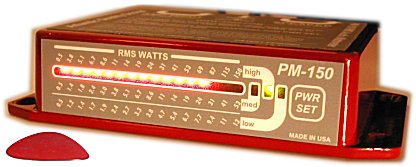 Our patented PM-150 Audio Power Meter is based on the MSP430, and takes advantage of its speedy execution of math operations to perform real time power computations. The PM-150 measures audio power, displays the measurement on the LED bar graph, and checks the power level against a user-set power threshold. If the threshold is exceeded, the low level audio signal level passing through the meter is attenuated to avoid speaker damage. See our power meter page for more details.
Our patented PM-150 Audio Power Meter is based on the MSP430, and takes advantage of its speedy execution of math operations to perform real time power computations. The PM-150 measures audio power, displays the measurement on the LED bar graph, and checks the power level against a user-set power threshold. If the threshold is exceeded, the low level audio signal level passing through the meter is attenuated to avoid speaker damage. See our power meter page for more details.
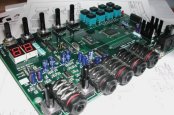 We have designed an audio effects device based on the MSP430 and Wavefront semiconductor audio DSP devices. In this system, multiple audio effects are selectable by the user with a keypad and LCD managed by the MSP430. As is typical with audio effects devices, many configurations are stored in nonvolatile memory for instant recall. The Wavefront DSP chips must be loaded with their operating code from the MSP430 as they have only RAM memory which does not survive power failures. Thus with each user-selected configuration, the MSP430 loads the Wavefront DSP devices with programs specific to the audio effects selected, such as distortion, chorus, and reverb.
We have designed an audio effects device based on the MSP430 and Wavefront semiconductor audio DSP devices. In this system, multiple audio effects are selectable by the user with a keypad and LCD managed by the MSP430. As is typical with audio effects devices, many configurations are stored in nonvolatile memory for instant recall. The Wavefront DSP chips must be loaded with their operating code from the MSP430 as they have only RAM memory which does not survive power failures. Thus with each user-selected configuration, the MSP430 loads the Wavefront DSP devices with programs specific to the audio effects selected, such as distortion, chorus, and reverb. 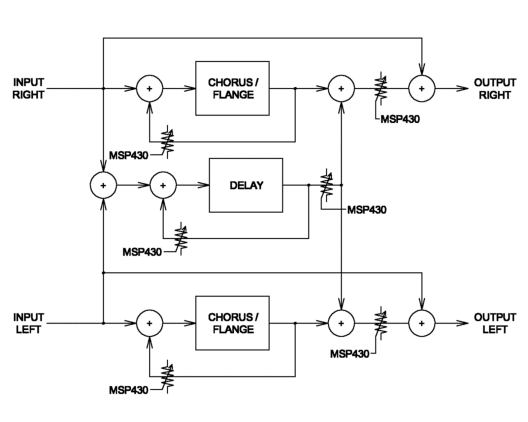 More interesting is that the MSP430 edits the DSP code in real time to effect filters and time changing sound effects. (See the diagram.) A parser that we wrote scans the DSP source code for special tags, then sends that information to the MSP430 program at compile time. The MSP430 knows at all times what algorithms are loaded in the DSP devices and how the front panel knobs affect those algorithms, changing mathematical parameters on the fly. Each potentiometer on the diagram is controlled by the MSP430, among other settings not shown. A prime example of this is our eStrap technology, which responds to the guitarists movement as he plays. That information is transmitted to the MSP430 wirelessly and used to modify the DSP algorithms in real time, for example, implementing a wah-wah effect or changing the rate of a low frequency oscillator. The MSP430 manages the user interface and DSP algorithms with time to spare. Intelligent coding and our custom parser links the MSP430 control program with the DSP algorithms to accomplish audio effects for a fraction of the cost of standard DSP chips.
More interesting is that the MSP430 edits the DSP code in real time to effect filters and time changing sound effects. (See the diagram.) A parser that we wrote scans the DSP source code for special tags, then sends that information to the MSP430 program at compile time. The MSP430 knows at all times what algorithms are loaded in the DSP devices and how the front panel knobs affect those algorithms, changing mathematical parameters on the fly. Each potentiometer on the diagram is controlled by the MSP430, among other settings not shown. A prime example of this is our eStrap technology, which responds to the guitarists movement as he plays. That information is transmitted to the MSP430 wirelessly and used to modify the DSP algorithms in real time, for example, implementing a wah-wah effect or changing the rate of a low frequency oscillator. The MSP430 manages the user interface and DSP algorithms with time to spare. Intelligent coding and our custom parser links the MSP430 control program with the DSP algorithms to accomplish audio effects for a fraction of the cost of standard DSP chips.
We have created special purpose test equipment for the designs we originate, for production test mainly. For example, we have created a guitar tuner tester that produces precise tones, for testing the accuracy and sensitivity of guitar tuners. All these devices are MSP430 based.
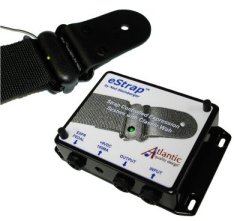 Our Wireless eStrap is a first of its kind device. The system senses the tension in the guitar strap and uses that to control sound effects as the guitarist plays. The system consists of a wireless transmitter which uses a strain gauge to sense the tension in the strap. The device sends the tension information wirelessly to a receiver unit nearby. The strain gauge is read by the MSP430 using a low cost method that employs a ramping RC waveform and a time measurement to determine the strain bridge value, rather than an expensive strain gauge amplifier. The eStrap receiver catches the transmissions from the strap unit and controls either a built-in wah-wah effect, or sends a control signal to external audio effects units, simulating a foot pedal with a potentiometer. Various incarnations of the eStrap system have been created, all based on the MSP430. Features have included wired and wireless operation, multiple pushbuttons on the strap transmitter unit, extensive sound effects in the receiver unit, and MIDI control.
Our Wireless eStrap is a first of its kind device. The system senses the tension in the guitar strap and uses that to control sound effects as the guitarist plays. The system consists of a wireless transmitter which uses a strain gauge to sense the tension in the strap. The device sends the tension information wirelessly to a receiver unit nearby. The strain gauge is read by the MSP430 using a low cost method that employs a ramping RC waveform and a time measurement to determine the strain bridge value, rather than an expensive strain gauge amplifier. The eStrap receiver catches the transmissions from the strap unit and controls either a built-in wah-wah effect, or sends a control signal to external audio effects units, simulating a foot pedal with a potentiometer. Various incarnations of the eStrap system have been created, all based on the MSP430. Features have included wired and wireless operation, multiple pushbuttons on the strap transmitter unit, extensive sound effects in the receiver unit, and MIDI control.
We have designed sports trainer and scoring devices which help athletes enhance their performance by providing immediate feedback. One device helped runners by measuring starting block exit and sprint speed. Another device measured golf drive performance. These devices were MSP430 based and took sensor inputs, made timing measurements, and displayed the results on an LCD for the user. We have also designed test and scoring equipment for sport fencing use. This equipment is unique in that it has to discriminate sub-millisecond touches between fencers who are typically wearing sweaty and dirty metal-threaded clothing, and wielding steel weapons partially coated in rust. Thus, contacts between fencers are not always clearly indicated, but the scoring apparatus must not miss any touches or indicate false touches. This requires an artful mix of hardware and software to satisfy sometimes finicky fencers.
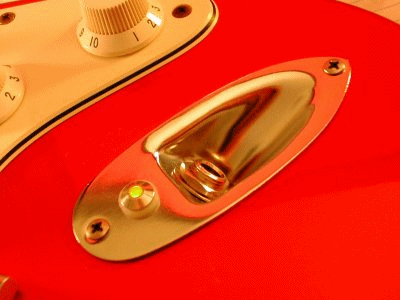 We have designed numerous guitar tuners for our own sale and for our customers, some which we have patented. Several of these are MSP430 based. Guitar tuners are not trivial to design because 1) the market demands accuracy on the order of stock quartz crystal accuracy, 2) the signals coming off the guitar string are not sinusoidal but rather contain a mixture of noise and harmonics, 3) every instrument produces different signal characteristics, 4) guitar tuners must be inexpensive, prohibiting DSP chips and algorithms from being used, and 4) boilerplate FFT signal processing techniques are inadequate to the task. With these difficulties, we have used the MSP430 to implement multiple tuners with high accuracy and repeatable performance. This requires a combination of hardware and software finesse. We have been asked to fix and evaluate numerous tuner designs from other vendors.
We have designed numerous guitar tuners for our own sale and for our customers, some which we have patented. Several of these are MSP430 based. Guitar tuners are not trivial to design because 1) the market demands accuracy on the order of stock quartz crystal accuracy, 2) the signals coming off the guitar string are not sinusoidal but rather contain a mixture of noise and harmonics, 3) every instrument produces different signal characteristics, 4) guitar tuners must be inexpensive, prohibiting DSP chips and algorithms from being used, and 4) boilerplate FFT signal processing techniques are inadequate to the task. With these difficulties, we have used the MSP430 to implement multiple tuners with high accuracy and repeatable performance. This requires a combination of hardware and software finesse. We have been asked to fix and evaluate numerous tuner designs from other vendors.
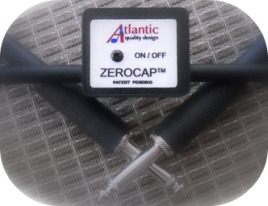 Our patented ZEROCAPTM Ultra Low Capacitance Guitar Cable line is MSP430 based. The micro is used to control the power profile of the product to maximize battery life. Some of our projects use MSP430s to do complex, performance critical tasks. In other cases, we use MSP430s as logic replacement devices. The internal oscillators make for a very low component count, very flexible logic replacement solution.
Our patented ZEROCAPTM Ultra Low Capacitance Guitar Cable line is MSP430 based. The micro is used to control the power profile of the product to maximize battery life. Some of our projects use MSP430s to do complex, performance critical tasks. In other cases, we use MSP430s as logic replacement devices. The internal oscillators make for a very low component count, very flexible logic replacement solution.
We have created MSP430 based magnetic sensing applications utilizing the Honeywell sensor line. These applications are sensitive enough to measure the Earth’s magnetic field and typically involve measuring a field strength in some physical orientation, then displaying the difference between a computed position and the goal position. These applications involve tending the sensors, which require periodic current pulses for zeroing, selecting proper gain settings, and displaying the measurement results. Low power battery operation is mandatory.
 We have designed distributed systems consisting of temperature alarms, data collection devices, contact closure and humidity sensors, all funneling data to an embedded web server and internet database server. There is a mixture of wired and wireless devices, with the wireless devices using the TI Chipcon parts. All these devices are MSP430 based and feature analog measurements, temperature sensor linearization, LED and LCD based user interfaces, RF transmission and reception, data aggregation and storage, power management and battery operation, and internet protocol based transmission of data. The use of common MSP430s in these designs allowed multiple devices to share code, reducing development time dramatically. Some of these devices have MSP430 based test fixtures for production testing.
We have designed distributed systems consisting of temperature alarms, data collection devices, contact closure and humidity sensors, all funneling data to an embedded web server and internet database server. There is a mixture of wired and wireless devices, with the wireless devices using the TI Chipcon parts. All these devices are MSP430 based and feature analog measurements, temperature sensor linearization, LED and LCD based user interfaces, RF transmission and reception, data aggregation and storage, power management and battery operation, and internet protocol based transmission of data. The use of common MSP430s in these designs allowed multiple devices to share code, reducing development time dramatically. Some of these devices have MSP430 based test fixtures for production testing.
 Our patented guitar pickup database gets its data from an MSP430 based test handheld instrument that we designed. This device generates a test signal for application to each pickup tested and listens to and records the signal from the tested pickup. This information is stored in a nonvolatile memory by the MSP430 for later retrieval, reduction and loading into our database. The instrument is small and designed to allow collection of pickup frequency response curves while guitars are hanging on the wall in a guitar store. Check out The Guitar Pickup Tone Database.
Our patented guitar pickup database gets its data from an MSP430 based test handheld instrument that we designed. This device generates a test signal for application to each pickup tested and listens to and records the signal from the tested pickup. This information is stored in a nonvolatile memory by the MSP430 for later retrieval, reduction and loading into our database. The instrument is small and designed to allow collection of pickup frequency response curves while guitars are hanging on the wall in a guitar store. Check out The Guitar Pickup Tone Database.
As you can see, we have expert level knowledge of the TI MSP430, and a huge prior design base on which to draw for new designs. And we have done many other MSP430 designs which are confidential and may not be disclosed here. Call us today to discuss your next project.
